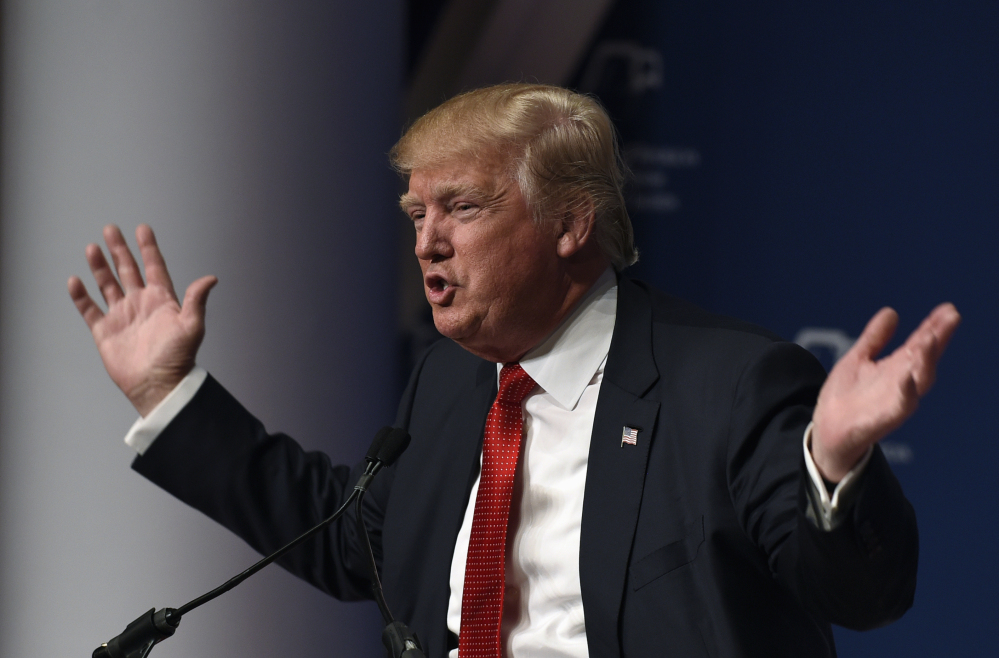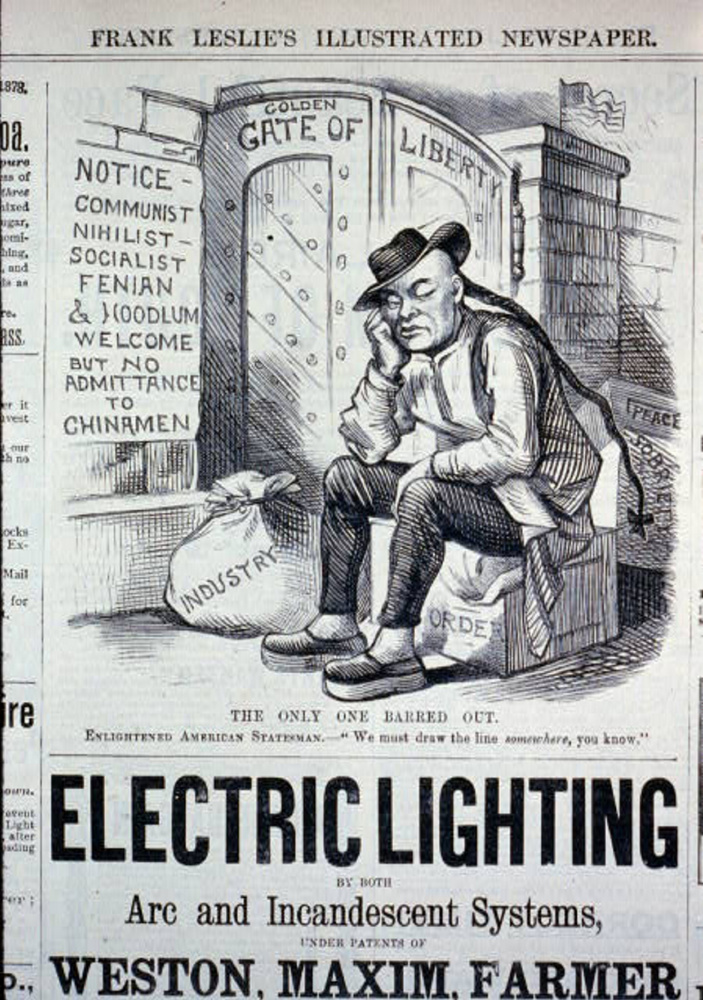The “Chinaman” was a familiar figure to many Americans in the mid-1800s. His likeness was unmistakable: slit eyes, a perpetual grimace, traditional loose-fitting garb and a long, snake-like ponytail tightly tied to an otherwise bald head.
He looked like an unsavory character – and most importantly, an alien one. The first major arrival of Chinese immigrants to the United States occurred during the California Gold Rush of the late 1840s, and with them emerged a strong current of anti-Chinese sentiment. From the very beginnings of their presence in the country, Chinese people were regarded as dangerous foreigners who took jobs and opportunities away from hardworking Americans.
Under those circumstances, it was almost inevitable that a political movement would arise in the name of eliminating a group widely regarded as a social and economic ill. The 1870s saw the formation of the Workingmen’s Party of California, whose motto was simply and succinctly “The Chinese Must Go!”
Within a decade, its campaign succeeded, contributing to President Chester Arthur’s 1882 signing of the Chinese Exclusion Act: the first federal law to exclude a specific ethnic group from immigrating to the country.
The Chinese Exclusion Act is also the closest cousin to what Republican presidential candidate Donald Trump proposed Monday when he called for a “total and complete shutdown” of Muslims entering the U.S.
It goes one step further than the U.S. Congress-backed 1882 legislation, which excluded Chinese laborers from entering the country under penalty of imprisonment and deportation. It also prohibited existing Chinese immigrants from seeking American citizenship.
Trump’s ban on Muslims would apply not only to prospective immigrants but also to tourists and others visiting the country.
Versions of the Chinese Exclusion Act persisted for decades, becoming increasingly restrictive. The Immigration Acts of 1917 and 1924 excluded all classes of ethnic Chinese and further banned all visa types for arrivals from a defined “Asiatic Barred Zone” which included India, Afghanistan, Persia (modern-day Iran), Arabia, Southeast Asia, the Asian-Pacific Islands as well as parts of the Ottoman Empire and Russia. (Japanese immigrants had already been barred through the “Gentlemen’s Agreement” of 1907.)
Extending from the Arabian Peninsula to Indonesia, this “zone” encompassed most of the Muslim world at the time.
Since it was repealed in 1943, the Chinese Exclusion Act has been remembered as a dark period in American history, when Chinese immigration all but halted for several years. Trump’s ban on Muslims would be an even more extreme iteration of this mandate, as it targets people based on religion instead of ethnicity.
OTHERS TARGET certain IMMIGRANTS
While Trump’s proposal has received almost universal condemnation from members of both political parties, the rhetoric surrounding exclusionary immigration measures through American history has been reprised by those – not limited to Trump – urging restraints on Middle Eastern refugee admissions to the U.S. today.
The position of politicians supporting the Chinese Exclusion Act was characterized in a biting editorial cartoon the year of its signing. The image shows the archetypal Chinaman sitting outside a door labelled the “Golden Gate of Liberty.” At the bottom of the cartoon, a caption reads “THE ONLY ONE BARRED OUT” and quotes an “enlightened American statesman” saying,” We must draw the line somewhere, you know.”
Many have used the same language to criticize the Obama administration’s assertion that Syrian refugees are thoroughly vetted before they are allowed to settle in the U.S. Republican presidential candidate Ben Carson said in a statement last month regarding the need to help refugees but also bar them from entry: “When we draw a line in the sand or boundary in the air, the world needs to understand that we mean it.”
The Chinese Exclusion Act was itself sold as a patriotic endeavor.
“The language of the act talks about the need to restrict as a matter of sovereignty,” immigration historian Erika Lee said in a phone interview with The Washington Post. “It was couched in terms of national security and the greater health of the country – the rhetoric was very similar to what we’re hearing today.”
The aim of the Workingmen’s Party, a labor organization with a particular focus on Chinese immigrant labor in the Central Pacific Railroad, was straightforward and supported by many Californians at the time.
The party channeled latent suspicions surrounding “Chinese cheap labor” into cartoonish depictions of a homogeneous group of immigrants supposedly bent on wreaking havoc on American life.
Aside from the caricature of the dirty, pilfering “Chinaman,” there were images depicting the Chinese as violent and destructive. One drawing offered an un-ironic representation of what would happen if you allowed a Chinese person into your home: they would start out as cute, harmless kittens and turn into monstrous tigers that murdered your entire family.
According to Lee, all these depictions contributed to a “rhetoric that tied national security with racial anxieties.”
“Chinese people were considered not only un-American but the opposite of Americans,” said Lee, who recently authored “The Making of Asian America: A History.” “They were considered diametrically opposed to what was America.”
Likewise, Trump has supported his idea of a ban on Muslims with claims that Muslim Americans harbor ill will against the country.
He wrote in his statement Monday:
“Without looking at the various polling data, it is obvious to anybody the hatred is beyond comprehension. … Until we are able to determine and understand this problem and the dangerous threat it poses, our country cannot be the victims of horrendous attacks by people that believe only in Jihad, and have no sense of reason or respect for human life.”
And as with the Workingmen’s Party’s slogan, Trump’s proposal is expected to be well-received by his base of supporters. David Brody, a correspondent for Christian Broadcasting Network, tweeted, “Here is the truth whether you like it or not: (Trump) is only candidate to have the bravery to put out that statement on Muslims.”
“Expect the (Trump) statement on USA Muslim ban to give him a boost with evangelicals,” Brody said in a subsequent tweet.
At a rally in South Carolina on Monday night, Trump called the idea of such an entry ban “common sense.”
“We have no choice,” he told a cheering crowd. “We have no choice.”
DIFFERENT HISTORICAL CONTEXT
The historic contexts, of course, are decidedly different. The Chinese were made economic scapegoats, blamed for taking jobs away from Americans; Muslims today are grouped together with terrorists. Islam has faced increased scrutiny in the past month alone, in the aftermath of Islamic State attacks on Paris and a mass shooting in San Bernardino perpetrated by self-proclaimed Islamic State supporters.
But in both cases, changing attitudes towards either group rely on developments in foreign policy.
The Chinese Exclusion Act was repealed two years after China became a U.S. ally in World War II. The policy change was accompanied by public relations campaigns to transform the image of Chinese people in the American psyche “after decades and decades of negative stereotypes.”
“TIME and Life magazine put up these articles called ‘How to tell your Chinese friends from the Japs,’ ” Lee said. “It was serious.” And anti-Japanese sentiments were reversed only after Japan became a democracy and an important U.S. partner during the Cold War.
“If history is any guide, our changing foreign relations will be a major factor in how we might lessen the Islamophobia that is circulating and growing today,” Lee said.
For Muslim Americans, the collective “burden” – as Lee put it – of proving that they are loyal Americans has been present since the 9/11 attacks, which set in motion a number of programs targeting Muslims for surveillance by the government.
The most notable among them was the National Security Entry-Exit Registration System, which singled out immigrant men from designated countries, all of which were predominantly Arab and Muslim except North Korea, to have their movements tracked and their points of departure limited while in the U.S.
Suspended in 2011, the program was criticized as “mandated ethnic profiling” on the scale of Japanese American internment during World War II and the “Operation Wetback” deportations of 1954.
But renewed calls to limit Muslim immigration emerged following the Paris attacks last month, when state governors vowed to reject incoming Syrian refugees and Sen. Ted Cruz, R-Texas, expressed support for a ban specifically on those refugees who are Muslim.
Trump’s call for a “total and complete” ban on Muslims entering the U.S. has received widespread criticism in part because it evokes a history widely considered shameful now, not just in its application to the Chinese but to a succession of ethnic and religious groups lumped together for exclusion at one point or the other: Irish Catholics, Jews, South Asians, Turks and Pacific Islanders, among others. Enacting such a proposal would mean going back 72 years in U.S. history, to before the Chinese Exclusion Act was repealed by President Franklin Roosevelt in 1943.
In his paper “Race, the Immigration Laws, and Domestic Race Relations: A ‘Magic Mirror’ into the Heart of Darkness,” University of California Davis law school dean Kevin Johnson contended that exclusionary immigration laws are in part reflections of prevailing opinions about racial minorities already settled in the U.S.
“For better or worse,” Johnson wrote, “the history of national origin and racial exclusion in U.S. immigration laws serves as a lens into this nation’s soul. … This phenomenon is not limited to racial minorities, but applies with equal force to other groups who have been excluded from our shores under the immigration laws.”
Send questions/comments to the editors.




Comments are no longer available on this story